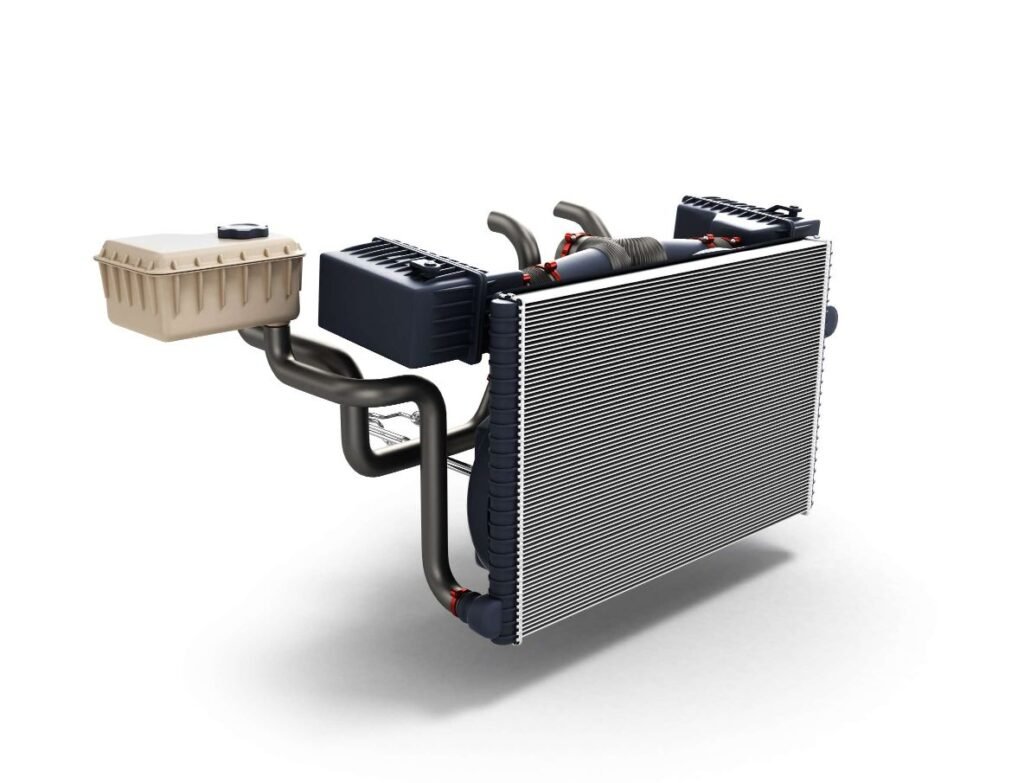Radiator

Ever wondered what helps your engine from getting overheated and what goes behind the smooth functioning of your car? The engine can become quite hot as a result of its power and numerous moving parts. To prevent overheating, which can cause serious damage, the engine must be vented of this heat while it is running. Under the hood of your car, there is an entire cooling system at work that makes everything happen so efficiently. A radiator, thermostat, water pump, cooling fan, etc are a few important parts of a cooling system. Today in this article we will learn all about the radiator.
Radiator
Engines can create a lot of heat in their functioning. To prevent overheating your car’s cooling system steps in. Coolant in the water pump receives heat and carries it away from the engine block. The coolant transfers the heat produced by your engine to your radiator, which circulates air across the liquid to reduce its temperature and exchange heat with the ambient air outside of your automobile.
Recommend Read: All You Need to Know About Car Brake
How does the radiator work?
Each side of a radiator has a tank that houses a transmission cooler. There are intake and output ports, and from the inlet port coolant goes to the tubes where it is exposed to cooling. In order to remove heat from the core, the tubes are parallel to one another and come in contact with cooling fins. The cooling fan behind the radiator reduces the heat in the tubes as hot water flows through the inlet port. After cooling the hot component again, the cool coolant returns through the engine’s outlet port.
Where is the radiator located in the car?
In front of the engine, under the hood, is where you’ll find the radiator. The coolant reservoir is located next to these components as well.
Parts of the radiator?
Core
The radiator’s largest component is its core. It is a metal block with metal cooling fins that aid in air venting. Hot liquid releases heat in the core, where it is cooled before being sent through the process once more.
Pressure Cap
The cooling system is sealed with the aid of the pressure cap, allowing for continued pressurisation. The radiator’s coolant is under pressure to keep it from boiling. It also keeps the system running more smoothly.
Inlet and outlet tanks
These tanks, which are placed in the radiator head, are where the coolant enters and exits the radiator. The hot liquid is entered through the inlet tank which after cooling, exits the engine through the outlet tank and back into the engine.
Radiator hoses
The radiator hoses allow coolant to flow through the engine. They are crucial to connect inlet and outlet tanks to the engine and radiator.
When should you change your car’s radiator?
There are some signs you need to look out for to determine if your radiator needs replacing.
Looking coolant
When green liquid is discovered under a car, the radiator should be checked to see where the leak is occurring. A radiator hose can also be the source of a leak that is easily identified.
It is possible to locate the leak by checking to see whether any steam is emanating from the radiator. Hoses need to be replaced regularly to maintain a properly functioning radiator.
There could be rust
If the radiator is completely covered in rust, the cooling system may sustain serious harm. When a bit of rust enters the engine and mixes with the coolant, it can create a thick liquid that prevents the engine from cooling. When this happens, the radiator needs to be flushed to get rid of all the rust-infested coolant. Coolant and rust together can create a sludge that can cause corrosion.
Overheating
A thermostat in the engine records the coolant’s temperature. A signal is sent to your gauge if the temperature gets too high. Then it is suggested that you pull over the car and let the engine cool. But this is a clear sign of radiator failure.
How to take care of the radiator?
The average lifespan of a radiator is around 8-10 years. But you can try some ways to keep your radiator last longer. They are
- Replacing or topping up your coolant
Coolant may become tainted with dirt and particles. Your radiator may become clogged with contaminated coolant, which increases the possibility of corrosion. Fresh coolant, on the other hand, will move through your radiator more smoothly and spare its components from wear. So, it is important to perform this task often.
- Reducing the mileage you drive
Although it may sound obvious, if your annual mileage is low, your radiator will have less work to do than if you cover a longer distance.
- Better quality radiator
Choosing better quality materials like brass and copper over aluminium and plastic would serve your purpose more efficiently. Plastic expands overheating and contracts while cooling down. This excess heat can severely damage the components of your car and end up costing more money to repair.
- Do Not overload your car
The more weight your vehicle must transport, the harder your radiator will have to work to keep your car cool. Due to the higher strain on the engine and resulting increased stress on your automobile, overloading is a significant contributor to your car overheating.
The purpose of radiators is to remove heat from the engine. The hoses carry the coolant from the radiator through the engine, where it absorbs extra engine heat, and then returns to the radiator.




















































